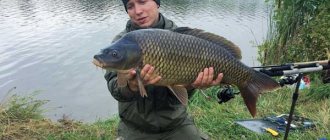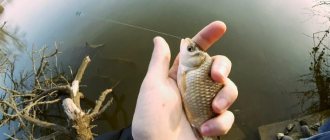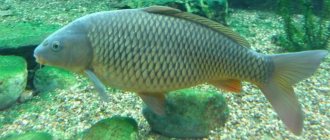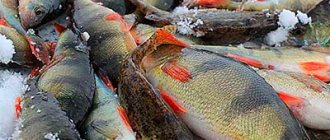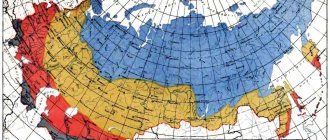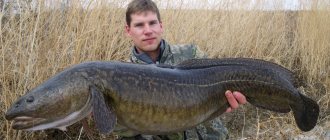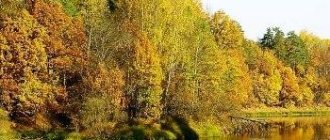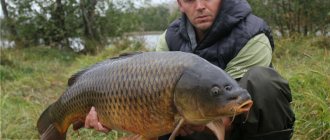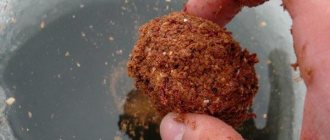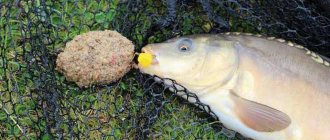Catching carp very exciting activity. Unlike its cultivated relative, wild carp (carp) can be very aggressive and voracious. Under favorable conditions, it can grow to impressive sizes and weigh more than 10 kg. This makes it one of the most favorite trophies for many anglers who engage in feeder fishing.
General information about fish
Catching carp using a feeder is very interesting, since a fight with such large prey is always accompanied by unforgettable emotions. Wild carp behaves like a real hunter, who confidently pounces on the bait and tries to take it to the depths.
The inhabitants of wild bodies of water are characterized by an elongated body, which is due to their lifestyle and regularly covering long distances in search of food. Also, young individuals need to constantly run away from danger in the form of predators. In such conditions, excellent endurance and the harsh disposition of the fish are formed.
The presence of powerful pharyngeal teeth allows the carp to freely chew hard mollusks or crustaceans, which occupy a large share in the daily diet. In addition, the carp eats all kinds of vegetation, which ensures a comfortable existence in the reservoir. However, it is inappropriate to compare the lifestyle of wild and domesticated specimens.
The former prefer calm waters with an abundance of plants and easily accessible food. The growth rate of river or lake carp is determined by both the food supply and the activity of the fish.
In mid-latitudes, the population of carp is quite large, but catching it is problematic. Because of this, feeder fishing takes on a special excitement and can take several days. And only a brave fisherman with nerves of steel and character gets a chance to get another trophy from the depths of the water.
Individuals that have reached the age of 2-5 years are considered sexually mature. The spawning period begins in mid-spring, when the water temperature exceeds 18-20 degrees Celsius. Often fish spawn at night, and this process is accompanied by special noise. It is not difficult to distinguish a female from a male, because her belly is completely stuffed with caviar.
Fishing Features
The process of catching carp in a wild pond or lake is very different from fishing in stocked reservoirs. the latter are essentially cages. The artificial environment forces the fish to stay in close quarters. In such “cramped” living conditions, fish will bite at everything that is offered to them. Carp that survived in the conditions of a wild reservoir. The fish that experiences powerful fishing pressure is distinguished by intelligence, cunning and quick wits. This is clearly manifested in its behavior and attitude towards baits, lures and bait.
The main feature of fishing in wild bodies of water can be safely considered that the search for carp there very often needs to be done in strong and heavily snagged “dead” places. In terms of lifestyle, our carp is very different from its counterparts who live in European reservoirs. In European reservoirs, carp swim freely throughout the entire water area and are not afraid to swim to the shore. Carp are attracted by splashes or shocks. They know it's food.
Article on the topic: How does smoking affect the carp bite?
In our reservoirs, any loud sound causes carp to hide in snags. This is explained by great pressure from fishermen. In the summer, pressure from tourists and vacationers causes no less problems for carp. These include drunken groups who make noise, swim and throw garbage into bodies of water, as well as water extreme sports enthusiasts.
Constant living among snags leaves an imprint on the food supply of large fish. Its diet consists of molting crayfish, mollusks, snails, chafers, worms, including crawlers, which are washed off the banks in the rain. Carp also feed on plant foods. Everyone knows about this, but not everyone applies this knowledge correctly. It is believed, for example, that to attract carp you need to use a lot of sweet canned corn.
In fact, it's the other way around. Corn makes carp lose their appetite. He quickly gets full, stops moving and begins to digest this corn at the bottom. Scattering corn across a pond leads to a lack of bite, and this, by the way, applies not only to large carp, but also to its smaller brothers.
A lot of damage to carp - and a lot of problems for serious fishermen - stems from the use of various cake-based rigs. Everyone wants to catch big fish, but not everyone thinks that this requires special gear and baits. Cake is used in different versions, most often in the form of various nipples, the action of which is based on the fact that the carp sucks in food and throws out all foreign objects through the gills. The result of using such gear is sad.
Search for carp in rivers
And although wild carp are also found in reservoirs or lakes, most feeder operators prefer to catch them on rivers. In flowing waters, the likelihood of a good bite is much higher, provided that the angler uses the right tactics to find fish. When fishing at fisheries, it is enough to use aromatic bait and collect all the fish in one place. In the wild you have to be more creative.
Avid carp anglers have learned to track “carp trails,” which are characterized by one stable route and do not change for years. Knowing where such a point is located, it is necessary to carefully feed it with nutritious food. When studying the water area, you should highlight the most promising areas where fish can go. To determine the specifics of the bottom, you need to use the tapping method. Using a marker weight, you can find hard areas, depressions, holes and other interesting places.
If one carp bites, the rest of the flock should soon react, because the fish leads a group lifestyle. To keep the flock at one point, bait is used. It should be solid, not carried away by the current and not attract small representatives of the aquatic world. It is also important to choose natural aromas and tastes. It can be dry corn or boiled peas.
When fish activity is critically low, you can use “highly attractive” boilies.
Preparation of bait
The success of catching wild carp directly depends on the correct combination of ingredients and preparation of the mixture. Experienced fishermen recommend feeding promising waters several days before fishing, if possible. This will increase the likelihood of a good bite, because... the fish will begin to accumulate en masse at the feeding point and will constantly return back for a new portion of nutritious food.
To prevent the bait from being carried away by the current, it must contain clay, which can be found directly on the river bank. It not only makes the mixture heavier, but also makes it uninteresting for small fish.
The key components of bait can be pearl barley and millet. But you shouldn't cook it over fire. Instead, the porridge is poured with boiling water and steamed in order to maintain hardness, ensuring that small fish are cut off.
The use of bulk mixtures is not justified, because... they will be quickly washed out by water and will not be able to hold the fish in one spot. The steamed grain is mixed with clay in a ratio of 1/1. Then, based on the composition, small balls are molded and thrown into selected places. Feeding is best done from a swimming device or using a special slingshot.
To enhance the attractive aroma of the mixture, it can be diluted with corn CSL, which has a natural and attractive aroma. It is also possible to use beet molasses, which creates a cloudy cloud in the water.
Good feeding ensures long-term retention of carp in one water horizon.
Studying carp fishing spots
Fishing doesn't like to be rushed. On any fishing trip, you should have enough patience and time so that upon arrival at a new place, look around, leisurely walk along the shore of the reservoir, listen and watch the water, and maybe even talk with local fishermen. It would not hurt to examine the bottom; for this there are special devices - markers (marker floats), which will allow you to determine not only the structure of the bottom, but also depth changes and much more that will contribute to successful fishing.
Equipment installation options
Wild carp are characterized by quick and confident bites, so without hesitation they pounce on the bait and try to lead it to the side. To prevent the equipment from breaking and secure the fish on the hook in time, it is recommended to use self-cutting rigs, which include an asymmetrical loop or method. If there are trophy specimens nearby, a method feeder would be a relevant solution.
When choosing its weight, you need to be guided by the following features:
- Distance of throwing equipment.
- Test rod range.
- Current intensity.
- The volume of feed that is immersed in the feeder.
Feeders from the Kord brand and the Fox Carp Feeder model, weighing 60 grams, are in particular demand. They are equipped with plastic frames that are not subject to corrosive processes and occupy the correct position on the bottom. The nozzle is placed on the opposite side of the load in the upper part of the feeder. Due to its decent weight, the design provides the effect of “self-hooking” the prey when biting.
To prepare the classic version of the equipment, you should use:
- Ledcore with a lead core (its length will be 40-50 cm).
- Feeder.
- Igloo.
- Swivel.
- Leashes.
Where do carp live?
Carp is an unpretentious and very prolific fish, so it lives in abundance in most of the fresh water bodies of Eurasia. Lives in rivers, lakes, reservoirs, where there is a weak or medium current; in such reservoirs the water is warm. Carp also lives in small ponds with stagnant water, since it is not particularly demanding of the oxygen regime, but with the condition that the depth is at least 3 m, especially in the riverbed part. In shallow reservoirs, carp become small, since there is a constant lack of oxygen and a lack of protein food.
Leashes and hooks
To make leashes, soft, “quick-sinking” monofilament is used. The optimal length is 10-15 cm for calm water and 20-25 cm for areas with intense current. If you need to fish points with complex terrain and an abundance of shellfish, it is better to take material with braid, removing it only in the last 2-3 cm before the hook.
When fishing for wild carp, you should use hair rigs that will allow the fish to survive in the event of a break or being thrown back into the water by the fisherman. Using classic leashes with sharp hooks is dangerous, because... The carp swallows them completely and receives a lot of fatal wounds.
Hair options are interesting not only from the point of view of safety, but also effectiveness. Experienced carp anglers recommend buying hooks No. 4-8, but the exact size is determined by the size of the nozzle.
The use of strong and sharp hooks guarantees reliable hooking and successful landing of fish.
Carp fishing on the lake (video)
Carp can be detected by the way the thickets of reeds or other growths in the coastal zone move and a splash is heard. This is how the fish feeds, while creating characteristic sounds, or as they say “smacking”. The location of the carp can also be determined by the rising bubbles that appear when the carp begins to dig through the mud. We recommend reading the article about making boilies with your own hands.
But other fish, such as bream, can behave in the same way; we recommend reading the article on carp habits for more complete information about it..
Good luck with your carp hunting, it is truly exciting!
Selection of nozzles
Since carp prefer to feed from the bottom, anglers prefer weighted baits with little buoyancy or sinking boilies. An excellent solution is the so-called snowman, which includes halves of floating and sinking boilies.
When fishing in warm water, the use of sweet flavors is allowed. Natural scents and spices work great in spring and autumn.
But experiments are allowed in the choice of fragrances, because... Fish preferences are constantly changing. Having completed the installation of the equipment, all that remains is to check how it behaves in water by placing it in a bucket of water. If everything is done correctly, the nozzle will rise slightly above the bottom.
Peas and corn are considered universal options for attachments, because... This is a natural food that is familiar to fish and has an effect at any time of the year. Using peas, you need to boil them a little and then place 2-3 peas on a hook.
The corn should be old, previously soaked in warm water. You should not combine both attachments on one hook, because... too intense a smell only scares away the fish.
River mussel meat can also be used as bait. However, such food is quickly knocked down by small fish, and fishermen often do not even have time to notice how the hook turns out to be empty.
Favorite places for carp in reservoirs
These are, first of all, dams, or rather dumps near them. The colder the water, the deeper the carp will go, sometimes the depth reaches 6 meters, although it is a small fan of deep reservoirs, but there can be impressively sized specimens there in the vicinity of catfish.
A favorite place for carp, dense reed thickets along the banks, bushes with branches hanging over the water. Also river beds and ravines, in these places carp can be found at any time of the year. River carp likes to inhabit the reaches of large or medium-sized rivers, oxbow lakes or backwaters where the current is weak.
Another favorite place for carp is snags; it is better if it is located far from the shore. The carp bite will be very interesting in such places; it will not be afraid of a heavy sinker and will hardly be able to quickly hide in a snag.
